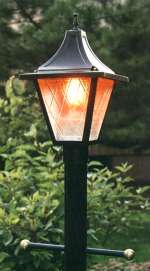Search engine visitors - click here to access entire "$ensible Home" web site
Click here to see a descriptive illustration of several designs of new residential HID outdoor security lights.
Dear Jim: There were some break-ins in my neighborhood this past year, so I want to install some outdoor security lighting which can also be used when entertaining. What are my options and which are most efficient? - Ann J.

A: Installing outdoor lighting is one method to reduce the possibility of nighttime break-ins. Talk with your local police department about what types and the amount of lighting they recommend for your home. Based upon crime statistics for your area, the police can also recommend the appropriate on-time for your security lights. Obviously, the less time they are on, the less electricity you have to pay for.
Keep in mind though, outdoor lighting should be used in moderation. It consumes large amounts of electricity, contributes to global warming and creates problems for wildlife which navigate at night. Also, in major cities, outdoor lighting makes it almost impossible to see the stars at night. If you have ever been on Pike's Peak in Colorado on a clear night, you know how many stars there really are to be seen.
When comparing lights and determining how many you need, compare their light output lumens ratings. This is listed on the packaging. The wattage refers to how much electricity a bulb uses, not its light output. The actual light intensity on your house or the ground is rated in lux (lumens per square meter).
The keys to energy and environmentally efficient outdoor lighting is selecting the proper type of bulb, light fixture design and shortest on-time period. Using just two 150-watt floodlights at night can increase your electric bills by up to $100 per year. With several fixed floodlights around your house, would-be thieves can often figure a way to get around them without being seen.
In areas where you will not need the lighting for entertaining, install motion-sensing fixtures or add-on motion-sensing switches. You can find these at most home center stores. Motion-sensing lights greatly reduce the amount of on-time and increase the bulb life. Since the light is not on when the intruder arrives, he does not know to avoid it until it switches on from his movement and he is caught in lighted area. This generally scares him away. Better-quality models provide for adjustable distance sensitivity and on-times.
For areas where you want the outdoor lighting for both security and entertaining, select fixtures which direct the lighting downward in the specific areas needed. The minimizes light pollution in the night sky and may allow you to use lower wattages bulbs to save electricity. Add-on shields are available for existing floodlights you have already have. Other complete outdoor shielded fixtures, with a mirrored interior for efficiency, are available (www.theglarebuster.com).
As you would do indoors, use fluorescent tubes and CFL's (compact fluorescent lights) in your outdoor lighting fixtures. Some may not operate well at very cold temperatures, so check with the lighting manufacturer before selecting them for cold climates. Fluorescent lights are four times more energy efficient than standard incandescent bulbs and last 10 times longer. The light quality from the newer CFL's is similar to standard incandescent bulbs. For whiter light, select full-spectrum CFL's.
If you find a problem with CFL's outdoors during winter, use halogen or other efficient HID bulbs. Although these are not as efficient as CFL's, but they are still 15 percent better than standard incandescent bulbs. Halogen bulbs produce a very white light which is excellent when entertaining and it may enhance the appearance of your landscaping. Halogen bulbs can get very hot, so pay attention to the maximum wattage allowed for each light fixture. Mercury vapor bulbs also produce a very pleasing light.
Although they are substantially more expensive to install, LPS (low pressure sodium) outdoor lighting fixtures are very energy efficient. These are the type of fixtures used in most commercial parking lots. They use less than 15 percent as much electricity as incandescent bulbs. The only drawbacks are they take a short time to heat up to full brightness and the light is a monochromatic yellow. They will make you look like a corpse and may not be suitable for your entertaining areas.
Some of the newest fixtures use clusters of white LED's (light-emitting diodes). These are solid state devices, not actual bulbs, which produce a white/bluish light. LED's are extremely efficient and they last almost forever, up to 100,000 hours. The brightness of the light output is limited so they are best for lighting a specific small area. They are often installed in groups to light a larger area.
Instant Download Update Bulletin No. 558 - buyer's guide of 14 HID and fiber optic security/entertaining outdoor light manufacturers listing styles, materials (oak, cedar, metal, plastic), bulb types (compact fluorescent, fiber optics, high pressure sodium, metal halide, mercury vapor, quartz halogen), bulb efficiency, features, color quality characteristics, and cost-to-operate chart.
Dear Jim: My house has a cathedral ceiling in the living room. There is very little insulation between the ceiling and the roof. Does it make sense to add a new false roof and insulate beneath it? - Ed S.
A: That is one possible solution to your problem. You should not totally fill the space between the ceiling and roof with insulation on a cathedral ceiling because there needs to be open area for ventilation.
To avoid all the construction and new roofing costs, you might consider attaching a layer of rigid foam insulation under the ceiling. Finish this with drywall. You will loose only a couple of inches of ceiling height.